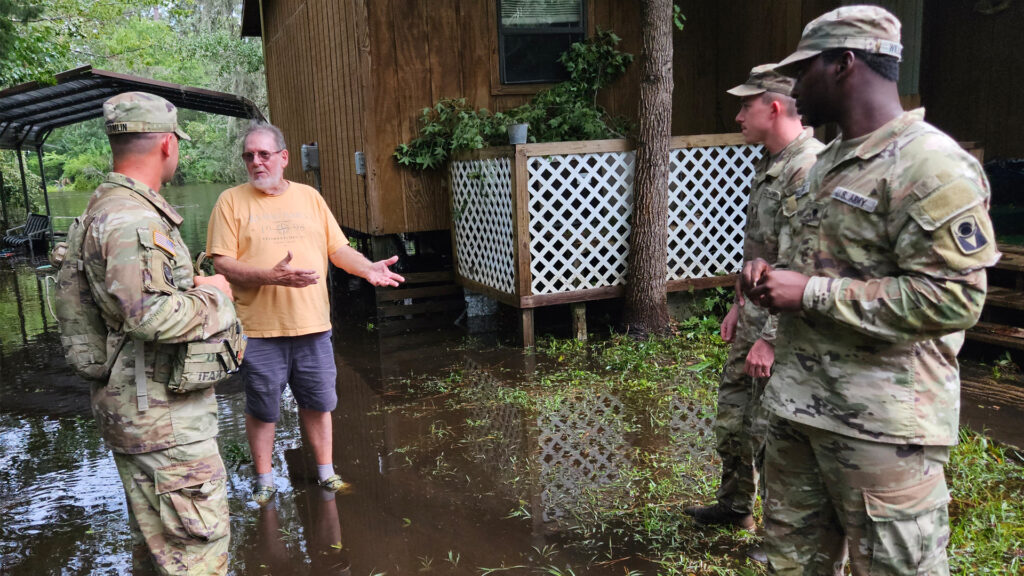By Jessie Ritter, National Wildlife Federation, and Josh Sewell, Taxpayers for Common Sense
It’s now officially the peak of hurricane season. And as Hurricane Idalia just showed us, it’s critical for communities to be prepared for the worst.

The National Oceanic and Atmospheric Administration (NOAA) recently warned that this year’s hurricane season may be more active than initially anticipated. That means Idalia likely won’t be the only major storm to threaten the Gulf Coast in the coming weeks. NOAA now predicts an “above normal” season with 14 to 21 named storms — including about half expected to become full-fledged hurricanes.
With storms now forming sooner and becoming more severe due to climate change, policymakers at all levels must do more to protect their communities from these natural disasters before they happen. After all, it only takes one bad storm to destroy generations’ worth of homes and livelihoods in a community, in addition to schools, hospitals and grocery stores.
It’s essential to invest in making communities more resilient in the face of potential natural disasters. Data shows that every dollar invested in pre-disaster mitigation can save up to $13 in federal spending. A recent report from SmarterSafer, a coalition of environmental, consumer, taxpayer, housing and other interests united behind policies to better mitigate natural disasters, documented how pre-disaster mitigation is a far more cost-effective approach than post-disaster recovery and rebuilding efforts.
Protecting communities vulnerable to hurricanes starts with investing in multi-benefit solutions to reinforce community resilience and withstand severe storms.
Nature can give us a head start. Efforts to conserve or restore wetlands, mangroves, dunes and other natural coastal barriers can guard against flooding, erosion and more. Trees and vegetation can act as sponges to absorb floodwater as well.
NOAA estimates that U.S. coastal wetlands alone provide $23.2 billion in storm protection each year. Nature-based solutions can also provide the surrounding communities with a wealth of ecosystem services, like cleaner air and water, recreational opportunities, increased biodiversity and carbon sequestration. One example is the Exploration Green Project in Texas, which transformed a defunct golf course into a 200-acre nature park and stormwater detention center, providing significant flood-risk reduction.

Human-made infrastructure should also be designed to be more resilient. Too often, roads, bridges and stormwater systems built in recent decades were designed without a changing climate in mind. This critical infrastructure is consequently often overwhelmed by disastrous flooding. But adapting our infrastructure to make it more resilient with up-to-date building codes we can save lives and taxpayer dollars.
When hurricanes do happen, we must have policies in place that help people recover faster. But the growing strength of floods and hurricanes is increasingly straining the health of the National Flood Insurance Program (NFIP).
Over the past 20 years, the program has been hit by major losses from a series of powerful storms, including Hurricane Katrina ($16.3 billion), Superstorm Sandy ($8.8 billion), Hurricane Harvey ($8.9 billion), Hurricane Maria ($11.1 billion), and Hurricane Ian ($3.5 to 5.3 billion). As of November 2023, the NFIP debt to the U.S. Treasury is now at $20.5 billion.
Unfortunately, lawmakers have repeatedly kicked the can down the road when it comes to the NFIP. The program is currently operating under its 25th consecutive short-term reauthorization.
Members of Congress appear likely to turn to yet another short-term extension when the current authorization expires on Sept. 30 – just as communities will likely be reeling from the worst of hurricane season.
One of the best ways to help communities vulnerable to hurricanes and flooding is by enacting meaningful reforms to the NFIP.

To accomplish this, flood premiums should reflect accurate levels of risk. Floodplain mapping should be modernized to include projections for future conditions. The start of Federal Emergency Management Agency’s Risk Rating 2.0 is a step in this direction, by freeing lower-income communities from subsidizing costs for coastal, high-income neighborhoods.
Considering that one home had 34 flood claims over a 32-year period, an improved approach to dealing with repetitive losses would significantly lower claims and costs and protect the people repeatedly exposed to disasters. As recommended by FEMA, it is important that risk-based rates be accompanied by a means-tested assistance program for low-income property owners who cannot afford their actuarial rates.
We should also expand the role of private insurance to close the protection gap. Facilitating public-private partnerships can give programs improved access to technology and capital that would increase efficiency and offset risk to taxpayers.
Proactive disaster mitigation policies save dollars and, most importantly, lives. Rather than kicking the can down the road yet again, policymakers must meaningfully invest in making our communities more resilient to hurricanes before it’s too late.
Jessie Ritter is associate vice president for water and coasts at the National Wildlife Federation. Josh Sewell is a senior policy analyst for federal agricultural policy at Taxpayers for Common Sense. This opinion piece was originally published by the Miami Herald, which is a media partner of The Invading Sea.
If you are interested in submitting an opinion piece to The Invading Sea, email Editor Nathan Crabbe at nc*****@*au.edu. Sign up for The Invading Sea newsletter by visiting here.



